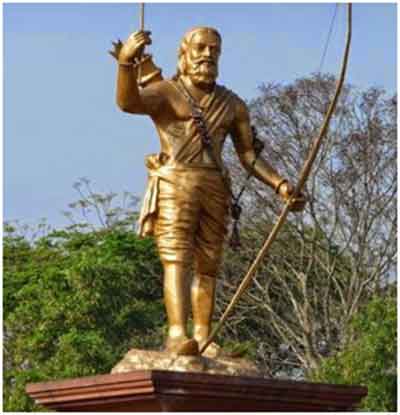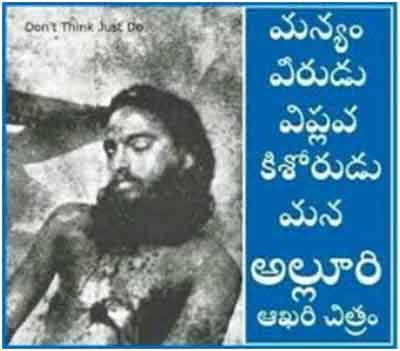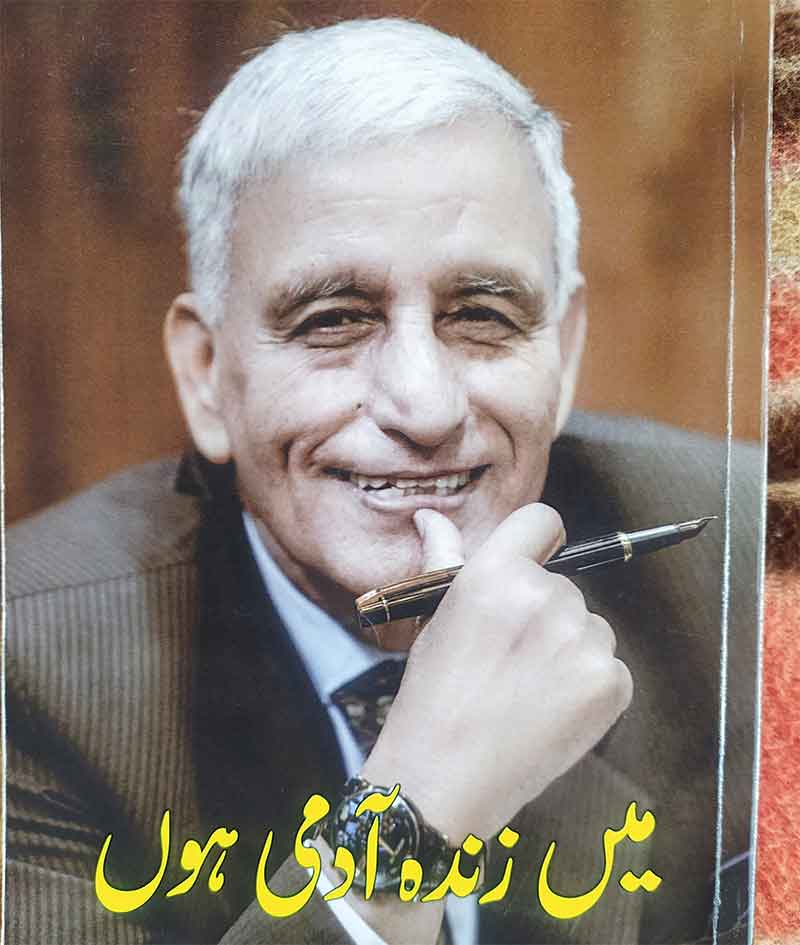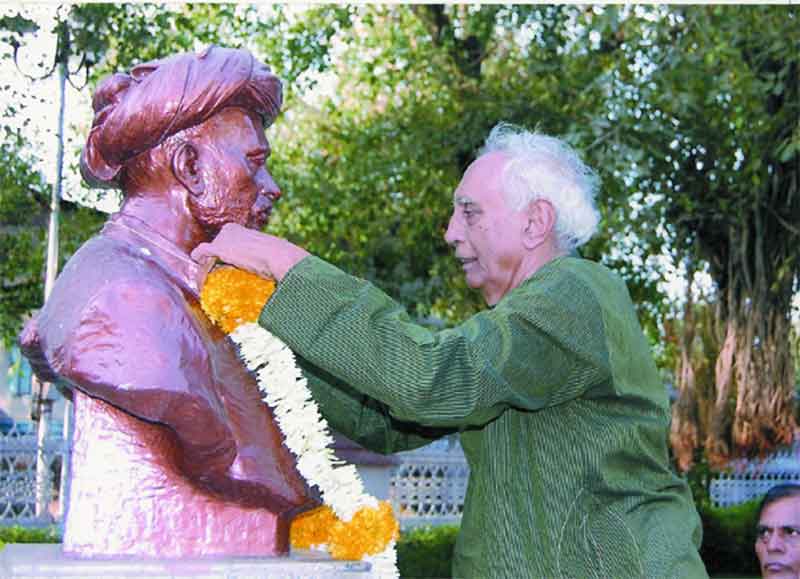
A statue of Alluri Srirama Raju, ( July 4, 2022 – May 7th 1924) with bow and arrows; this model is the standard depiction seen in most places, across the Telugu states of Andhra Pradesh and Telangana State. He is mostly presented in saffron robes of a Sanyasi.
A centenary of the popular armed struggle, Rampa Adivasi Revolt, led by Alluri, as he is popularly called by his surname, is being observed by people in both Telugu states. An official public meeting, attended by several Ministers, including Union Tribal Welfare Minister Arjun Munda (a Tribal leader from Birsa Munda’s home village), was held at Chintapalli, AP, in the newly carved ASR district named after him,on August22, 2022. Thousands of people, mostly adivasis joined the celebrations.
It was here in Chintapalli and on this day in1922 the local police station was first attacked by the armed fighters led by Alluri; it was part of Azadi ka Amrut mahotsav (Indian freedom movement-75).
Tribal leaders of AP including Dy CM Peedika Rajanna Dora and local MP and MLAs, besides others attended the function, and some welfare and memorial activities were announced.
Prime Minister Narendra Modi had earlier unveiled a statue and addressed a rally near Alluri’s home town Bhimavaram, AP, on July 4, 2022, to mark his 125th birth anniversary that will be celebrated in Delhi and Bengaluru, it was announced. It shows the popularity of the struggle, also filmed in 1974, which is sought to be encashed by ruling classes of today. Modi said the centenary of the Rampa Kranti will be celebrated throughout the year.
Following is a free translation of an article in Telugu, published on August 22, 2022. That was the day in 1922 when Alluri had launched his armed struggle against the British, preceded by an introduction that gives the context of the struggle, less known outside the Telugu states.
Introduction
Rampa Adivasi Revolt (1922-24) against the British was a militant armed struggle against the colonial rule, and is regarded as part of India’s freedom movement, which was being falsely presented as uniquely non-violent.
Struggles associated with the 1857 First War of India’s independence, unlike Alluri’s, that were highlighted by Rani of Jhansi’s battle and the like, and many that began long before 1857, were led by feudals in defence of feudatories that were being annexed by the British East India Company.
Alluri preceded Bhagat Singh (1907-1931) by a few years, and was killed in 1924. He was reportedly in touch with Ghadar Party, whose functionaries had met Raju. He lived with, worked and died for adivasis, with anti-colonial goals. Many militant struggles of such revolutionaries were more acts of individual heroism, short-lived, than popular mass struggles. Alluri’s was a unique struggle, being one among the earliest mass movements, waged in guerilla mode of struggle, that took three years to be suppressed by the British armed forces.
Through local contractors, British officers used to extract forced and free unpaid labor (corvee/vetti) for public works, like road-making, in forest areas and looted their homes lifting away their goats, fowls, honey, small forest produce etc, and violated their women.
There was enacted, ostensibly for the welfare and protection, of triblas and forests, Agency Tracts Interest and Land Transfer Act, 1917 (Madras Act of 1 of 1917), a so-called Tribal protection Act, by the then Madras Provincial Government. Non-tribals and outsiders were barred from buying properties in the Tribal Agency areas, among other provisions of this Act. That left the British with the opportunity to plunder forest wealth exclusively and loot the labor of the adivasis.
After the passing of the 1882 Madras Forest Act in an attempt to exploit the economic value of wooded areas, its restrictions on the free movement of tribal peoples in the forests prevented them from engaging in their traditional podu agricultural system, a subsistence economy which involved shifting cultivation. The changes meant that they faced starvation and their main means of living was robbed; facilitating the demeaning, arduous, foreign and exploitative coolie system use by the government and its contractors for such things as road construction.
A century after the struggle, in so-called free India now engaged in an Amrit Mahotsav (75 years of independence), ostensibly to protect forests, landless adivasi peasants are harassed, beaten up, framed in fake cases by the forest and police authorities, for engaging in podu (shift) cultivation. (see link at the end about current situation.)

The last picture of Raju, apparently a photo by the armed police, of the dead body soon after killing him. It is the model used for the postal stamp, given below, as can be seen.
May 7th 1924 was the day Alluri Sitarama Raju (1897 July 4– 7 May 1924), a unique revolutionary involved in the Indian independence movement, was killed by the British armed forces.
He was one of the few Indian revolutionaries, who had developed a mass base and a mass movement, that culminated in a sustained armed struggle (1922-24), and adopted guerilla methods and tactics of struggle in which hundreds of tribals, mostly Koyas, joined and fought like a rudimentary army. The rebellion was finally crushed, drowned in blood, spilled by the British colonial power. Besides local armed police, hundreds of men of Special Armed Forces of Malabar Police, and Assam Rifles, back from World War I, were deployed. Finally, he was captured, tortured, tied to a tree, and shot dead at point blank range, on May 7, 1924, at Krishna Devi Pet village of Visakhapatnam Dt. That was one of the first encounter killings of modern India, so common in India post-1947.
*** ***
Centenary of Alluri Sitarama Raju’s Revolution

A postal stamp (S.No. 1192) was issued on 26/12/1986, and released in his native village, Mogallu of West Godavari Dt, AP. 10 lakh copies of the stamp were printed and sold out.
Resistance to colonial rule was initiated by the adivasis in forest areas and that commenced long before in the plains. The Indian National Congress was formed at the end of 1885, but long before that, the Chaur armed rebellions (Jungle Mahal movement, 1771-1809) had already started in the hills of Bengal in 1766. It was only in the 1790s that their turmoil was visible.
Visakhapatnam Manyam Revolution was the last of the tribal movements that took place all over the country. Rebellions were not new to them. There were many sides to the movement led by Alluri Sitarama Raju or, to be accurate Sri Ramaraju, between 1922-24. The character Sita in his name was fictional.
The people of Manyam (tribal tracts) were stirred by Alluri’s nearly two-year long struggle, and terrified by the police harassment. Many of the adivasi activists were killed. The military tribunal sentenced up to 270 activists without proper trial. 12 people were sent to The Andamans.
Different paths
Many patriots who had chosen different- extremist, right-wing and revolutionary- ways to the Indian independence movement dedicated their lives for the same. Alluri Sri Rama Raju belonged to the class of the revolutionaries who wanted to take up arms against the British colonial rule. He observed the sufferings of innocent tribals from close quarters and realised that their problems could not be solved through petitions.
That is why he led a spectacular tribal rebellion in the Manyam region. Today marks the 100th anniversary of this sensational war waged by Alluri Seetharama Raju.
The tribal movements were part of the resistance to laws that sought to shackle free living from the forests and from their ancestors. Among such movements that took place all over the country, the struggle of Alluri in Visakhapatnam dt between 1922-24 was unique. They are all about the yearning and sufferings of a few generations of Adivasis for the right over Konda Kona, the hilly forest tracts.
Though they seem to have arisen on local issues, they are in fact wars against the British government.
There was a political consciousness and ideological shade in the Visakhapatnam manyam struggle that reflected the consciousness in the plains. Alluri-led army, during their raids on police stations, shouted slogans of Vande Mataram – ‘Ours is the kingdom’ and ironically ‘Jai to Gandhiji, who swore by non-violence.
The emergence of Sriramaraju as an activist took place in a historical context. The First World War, Gandhiji’s call for and withdrawal of the non-cooperation movement, and Alluri’s north Indian expedition gave that backdrop. In 1915, when his family was in Tuni village, Ramaraju went to North India in search of a job. During that yatra (travel), Ramaraju went to Calcutta and met Surendranath Banerjee, the leader of the famous national movement.
It was this yatra that extended up to Haridwar (and Nepal) that added the vision of the movement to the spiritual philosophy inherent in Ramaraju. Madduri Annapurnaiah, a contemporary of Alluri and a Congress Socialist leader of Andhra, wrote that in Ramaraju’s spiritual discourses patriotism was like sugar in milk.
This was the time when the First World War was inspiring the Ghadar Party to a nationwide movement. In the book¸ In praise of ‘Sri Alluri Seetharama Raju (1925), Bhamitipati Satyanarayana wrote that Ramaraju learned martial arts during the Great War.
Ramaraju had reached back Krishnadevipeta in the Eastern Ghats on July 24, 1917 as a spiritual leader.
There were many reasons why he took up the weapon and started the armed movement. In 1920, Gandhiji had called for a non-cooperation movement and gave the slogan of ‘Freedom in one year’. Congress activists like Rallapalli Kasanna from Narsipatnam and other areas also campaigned for non-cooperation in Krishnadevipet, where Alluri began his work.
In 1921, Ramaraju went to Nasikatrayambakam (Nasik) on foot. There, the influence of the ‘Abhinav Bharat’, revolutionary organization of the Savarkar brothers, was deeply felt by him. There were also orders to keep an eye on yogis and sanyasis. As soon as he arrived in Krishnadevipeta, the officials focused on him, and in January 1922, Raju the ‘Yogi’ was suspected as an activist of the non-cooperation movement: Ramaraju had already brought some reforms among the manyavasis, i.e, tribals, influenced by Gandhiji’s programmes like prohibition of alcohol, formation of panchayats (gram swaraj), and boycott of courts. He liked those programmes.
After the end of the First World War, there were hunger raids by people in the Madras Presidency due to the outbreak of drought. The government had started generating employment by some programs.
The construction of roads in Manyam was one of them. Their ways of construction of these roads was an inhuman event in the history of Asia. Gudem Deputy Tahsildar Alf Bastian was in charge of this program.
In fact, with the 1882 Act, the Adivasis who lost access to the forest already became landless labourers. In January 1922, former muthadar (tribal chief) of Peddavalasa village, Kankipati Balayya padalu (alias Yendu padal), Munasabu (official) of Battipanukula village, Gam Gantanna Dora, his younger brother Gam Mallu Dora, and others like great archer Gokiri Erresu, Sankoju mukkadu, Karri kannigadu, and Bonkula Modigadu came to Raju and told him of their travails caused by Bastian and Alluri keenly listened to him.
Sriramaraju had written a complaint against the British officer Bastian to the higher authorities. The complaint led to the allegation that Ramaraju had started non-cooperation movement in manyam. On January 29, the agency commissioner Swain held a panchayat (enquiry) in Krishnadevipeta alleging that Ramaraju was conducting a non-cooperation movement. Ramaraju was taken into custody on February 3, 1922, with the charge that he was a non-co-operative activist. Ramaraju was declared a political suspect and lodged in Narsipatnam jail.
The awareness of the Vande Mataram movement had increased in the country, and in Andhra. On Feb1st, Gandhiji had announced that he was intensifying the non-cooperation. Gandhi withdrew the call in the wake of the ‘Chauri Chaura’ incident on the 5th. He accused Indian people of not having the culture of fighting non-violently.
This was what led the youth towards other paths: Ramaraju was one such person.
Alluri wanted to organize adivasis and fight as guerrillas with traditional and modern weapons. It was decided to rob the police stations in Manyam for weapons. The followers were divided into three squads, under the leadership of Endu Padal, Gantanna and Ramaraju- Mallu.
On August 22, 1922, Chintapalli police station (PS) was attacked by 300 people, as recorded by police, and that too in broad daylight. E.Appalaswamy Naidu, Sub Inspector of Chintapalli PS, who met on the way, was told about the attack.
11 guns, 1390 bullets, 5 knives and 14 bayonets were taken away by the squads. Ramaraju left behind in the PS a letter saying that he was carrying them.
The political philosophy of the manyam movement was known by the very first attack: ‘Vande Mataram’ “Ous is the kingdom” and “Jai to Gandhiji” were slogans shouted during the attack.
On August 23, krishnadevipeta PS was attacked, and on August 24, Rajavommangi PS (East Godavari) was raided.
Mottadam Veerayyadora, who was arrested for the offence of defending Lagarai Pituri (revolt), was then in custody at the station. His release was also one of the aims of the attack.
With the first two attacks, telegrams went to R.A. Graham, Chief Secretary of the Madras Presidency: 26 guns and thousands of bullets in all were seized by the hill squads. What a danger! Agency district Superintendent of Police Sanders and collector reached Narsipatnam at a high speed. Manyam became the center of all their attention.
In such an atmosphere, Raju captured the equipment sent by the Maharaja of Jaipur (Odisha) on five elephants to the police at Onjeri Ghat on September 3. What followed disturbed the Madras Presidency. Ramaraju’s name was heard for the first time across the Telugu soil:
On September 24, 1924, Scott Covert and Neville Haiter, senior police officials of Orissa, were killed by Alluri’s forces when they went with two battalions and were on a search operation on the mountainous route of Damanapalli Ghat. Of these, Haiter had participated in the First World War. Both of them were shot dead by the hill brigade.
Malabar armed police and Assam Rifles deployed
The death of Covert and Haiter revealed that the local general police were unable to contain Alluri’s battles. On September 23, 1922, Malabar police forces were called in. These forces, which suppressed the Moplah(1921) revolts, were trained to fight in the hills. However, they collapsed in the Visakhapatnam hills. At a place called Ramavaram, the Malabar army, which fought with the Alluri’s army was defeated.
Subsequent attacks on Addatheegala(October 15), Chodavaram (October 19), Malkanagiri and Paderu police stations ‘failed’: weapons were not available. The British were ‘careful’ and sent weapons to the treasuries for their security.
On December 6, 1922, the Malabar army fought with Louis’ artillery against the Alluri’s army at Peddagaddapalem and Lingapuram. Eight followers of Alluri were martyred.
On December 23, the government announced prices for the heads of the activists. Four months later, on April 17, 1923, Ramaraju’s troop suddenly appeared at the Annavaram police station and disturbed the entire administration.
In December of that year, Ramaraju attended the Meetings of the Indian National Congress held in Kakinada in disguise: Mangipudi Purushottam Sharma had said that Ramaraju was present in the guise of a Sikh youth. Though it was the tribal movement that he led, Alluri continued to observe the freedom movement in the plains.
In January 1924, the Assam Rifles, led by Major Goodall, were deployed. They had experience in the First World War.
By then the number of government forces was almost a thousand. Alluri’s army was only one hundred strong, but they were guerrillas and sons of the soil with local support.
Thomas George Rutherford, who was the Collector of Guntur district, was appointed as the Special Commissioner of Manyam in April,1924, for concerted police action with a mission: The movement should be suppressed by June 24. A few more Assam Rifles troops had also arrived.
On May 5 or 6, 1924, Alluri and his troops camped at a remote place near the ‘Revula kantaram’. He had escaped from the police attack, and was the only one who came to the village of ‘Mampa’ at night and spent the night on a manche (watch-platform in a farm), that served as a bed.
Alluri was surrounded and arrested by armed forces led by Kanchu Menon and Intelligence Patrol Sub-Inspector Alwar Naidu, both of the East Coast Force in the wee hours of May 7 while he was bathing in a pond.
Orders were received to hand over Ramaraju alive to Rutherford. He was tied to a native cot used by adivasis and carried by the tribals and they proceeded to Krishnadevipet. Koyyuru is on the way. Major Goodall, the chief of the Assam Rifles who was present there, intercepted and forcibly took him to his tent, ostensibly to talk to him.
Ramaraju was tied to a tree and shot dead. The last rites were performed on the banks of the river Tandava in Krishnadevipet. On June 7, Gam Gantanna was also shot dead.
The people of Manyam were stirred by the nearly two-year agitation and terrorized by police harassment and tortures.
Some of the activists were killed by local police. The military tribunal sentenced up to 270 activists without proper trial. 12 people were sent to The Andamans.
The sacrifice of any section of the people who fought for the country is worth it. Alluri’s struggle did not go in vain: The British were forced to introduce some protective legislation (about tribals, and forests).
Only if all the struggles are recorded, it reflects the completeness of the history of the Swaraj struggle. That is the message of the 100 years of the Manyam movement!
*** ***
Dr. Goparaju Narayana Rao is a senior journalist, who travelled extensively, visited places and persons that were associated Alluri’s movement, and authored a well-researched book on him, titled Akupachcha Suryodayam, Manyam Veerudu Alluri Gaatha,2018.The article is a free translation of article published in Sakshi, leading Telugu daily, on August 22, 2022, the centenary day of the commencement of the adivasi revolt. It incorporates additional points, made elsewhere by the author.
*** ***
Annexure
A contemporary write-up is worth mentioning, a sort of disclaimer by Congress:
Dr. Bhogaraju Pattabhi Sita Ramayya (1880-1959), prominent Andhra leader of Congress, close to Gandhiji, and its President for some time, wrote an official and authentic History of Indian National Congress, in two huge volumes. Volume 1 (which itself was 700 pages) was published in 1935 December, about 11 years after Raju’s death. In it Pattabhi wrote :
…but the (British) government themselves attributed the rebellion in the Gudem agency – Godavari and vizagapatam districts of Andhra – under the leadership of Sitaramaraju to the subversive influence of the civil disobedience movement. They had made a similar mistake in regard to the Moplah rebellion.
The gudem rebellion also started some time in 1922 but later than the Moplah revolt but had nothing of the (Moplah’s) communal tension … Here also semi-military operations were necessitated and not much progress had been made by the end of the year 1923. In1924, the Assam Rifles were sent for, consisting of about 250 officers and other ranks. The rebellion was ultimately put down after nearly three years of Guerilla warfare between the mighty and puissant forces of the British government and Raju with the following of 200.
The above quotes are more an acknowledgement of his popularity than a reflection of their sincere views about Alluri. For, they often not only demarcated themselves from him, quite understandable, but never helped to protect him or the movement he led. In fact, when local Congress leaders gave telegrams about danger to his life, they were chided by Congress leaders – some of them called him a dacoit – and warned to keep away. A story similar to Bhagat Singh’s death sentence.
A letter dated1922 June 14 by Alluri to the Muthadar , Chekka Lingam dora of Dopparti village reveals that he surrendered 50 acres of his patta land located in Paidiputta village;some presumed it was meant to meet costs of the revolt.The letter says he was going to Nepal.
See for more details on Alluri an article of 07/05/2020 in countercurrents.org:
Despite claims of tribal welfare by Union and state governments, and enactment of Forest Act 2006, adivasis are deprived of their rights, and harassed, beaten up, and tortured by the state agencies. The Organization for Protection of Democratic Rights [OPDR] in Telangana State constituted a fact-finding committee under the convenorship of a renowned democrat, former M.P., Mr. Solipeta Ramachandra Reddy, to investigate the ground reality. The Committee held meetings with about 250 farmers last year ( 4-08-21 to 7-08-21) and published a Report. OPDR leader Dr S Jatin Kumar wrote an article (dated 26/08/2021) for countercurrents.org.
Conflict on podu lands in Telangana: cultivators in dismay – “We won’t leave the lands” they say
An year after that, adivasis are still deprived of their rights , and still face worst repression, reminiscent of colonial rule. Adivasis led by GPS are putting up resistance.The article mentioned below, by ChSN Murthy,dated 30/04/2022, gives a picture of the same:
Adivasi pesants of Telangana led by GPS Conduct Dharna for land rights, https://countercurrents.org/2022/04/adivasi-pesants-of-telangana-led-by-gps-conduct-dharna-for-land-rights/
















































